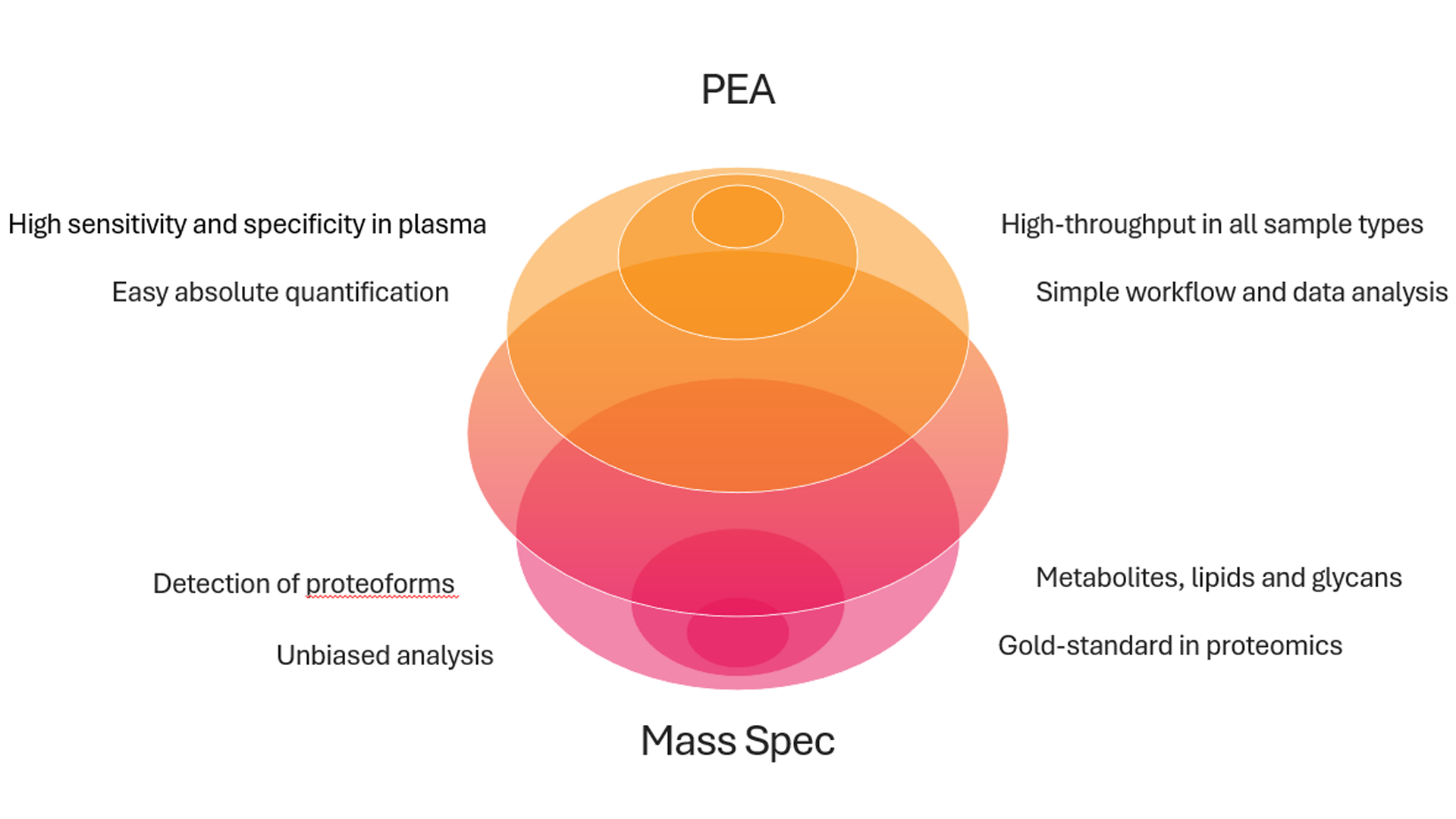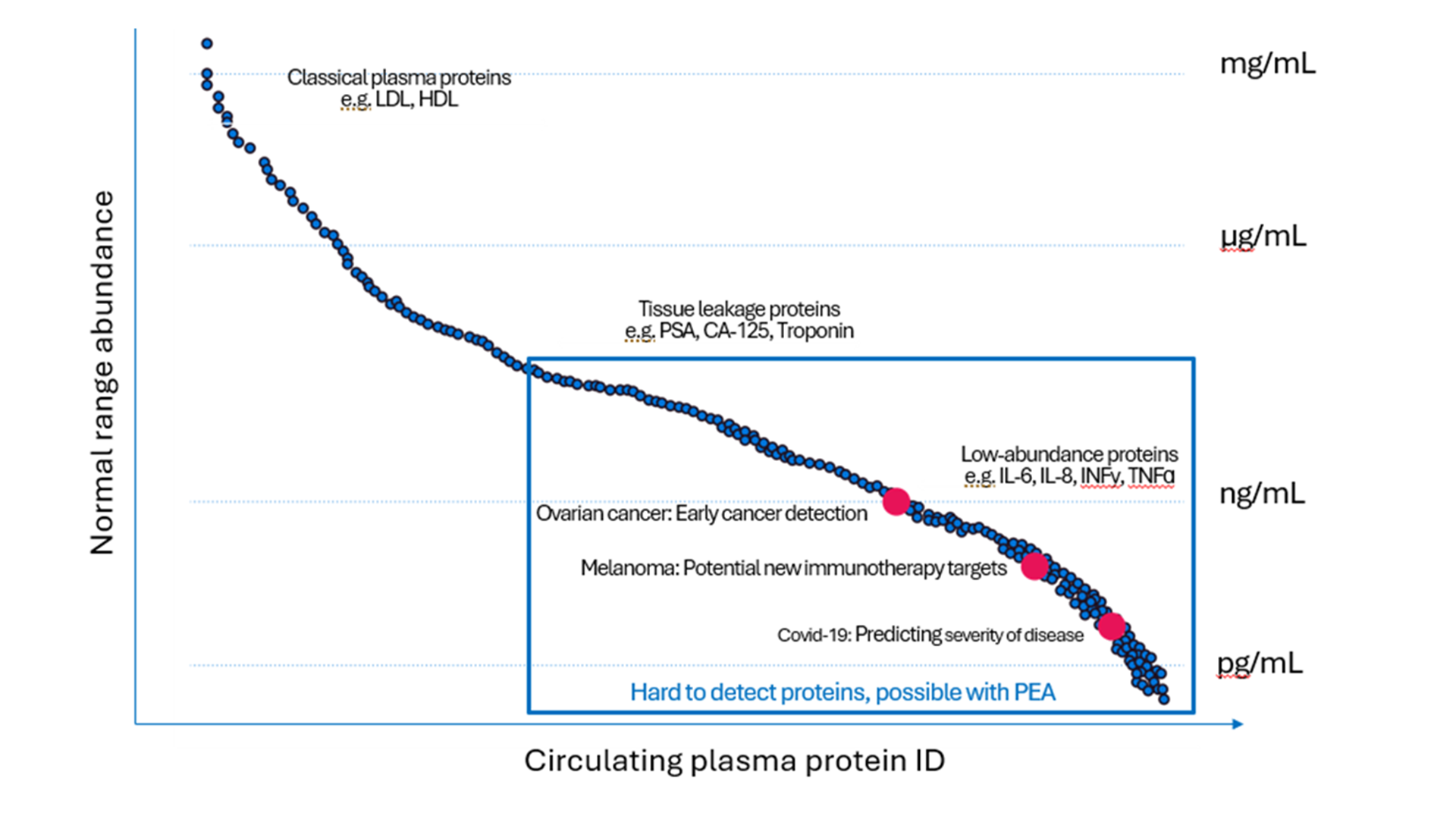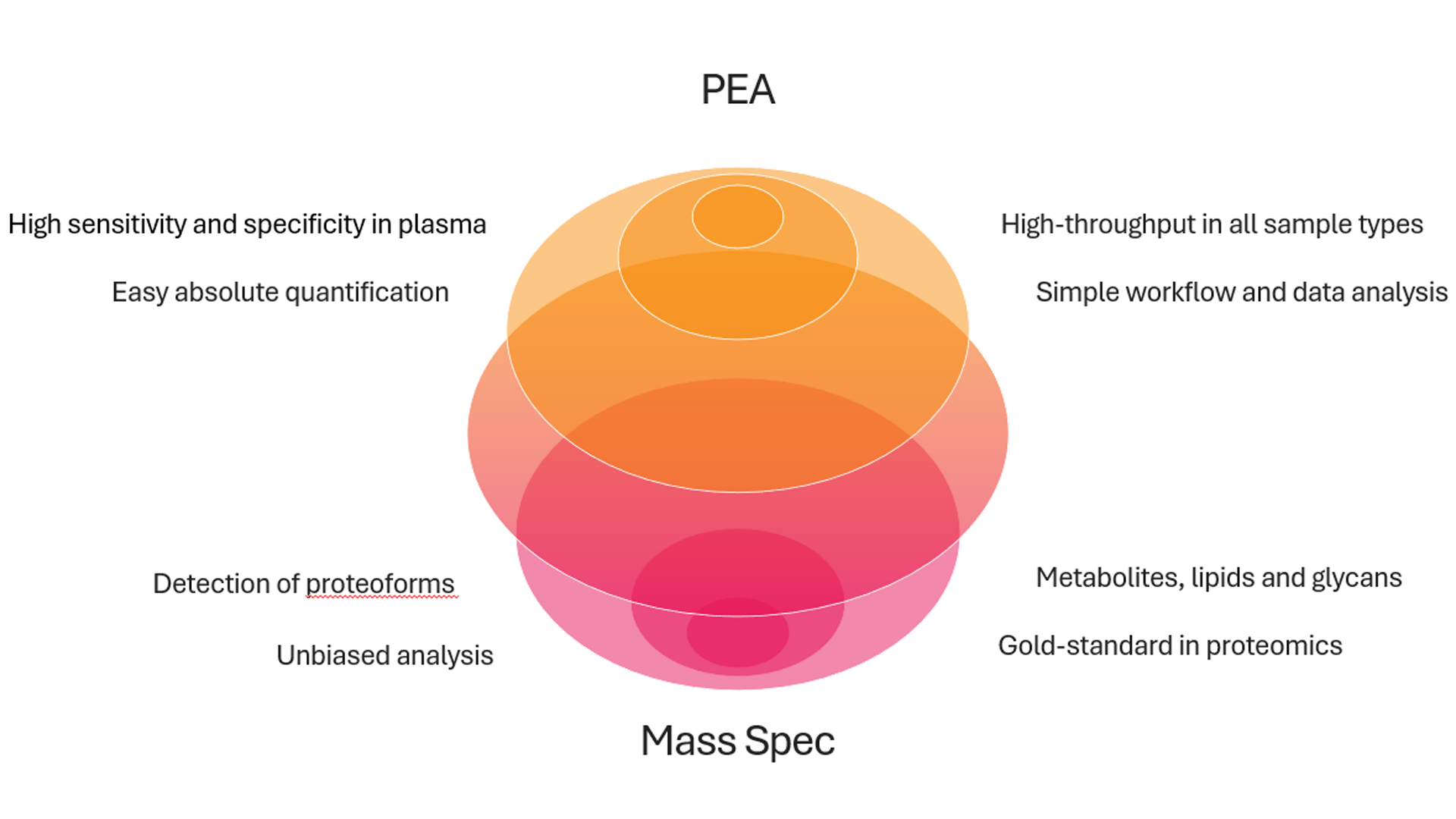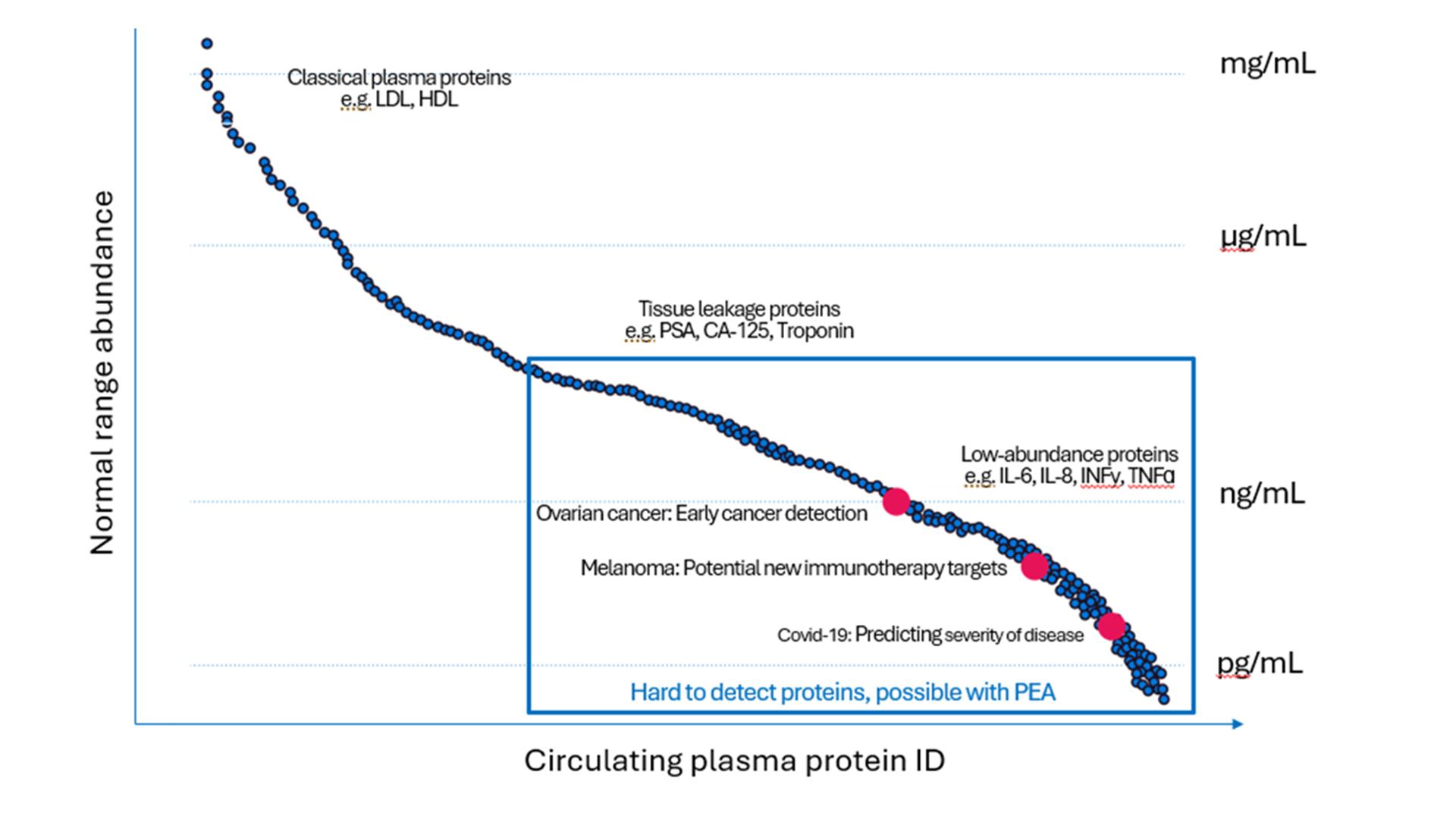Complete your proteome picture
by gaining access to the low-abundance proteome with ease
A powerful synergy that lets you go deeper
Plasma proteomics offers a minimally invasive path to relevant biomarkers but is challenged by the plasma proteome’s vast concentration range. Mass spectrometry remains the gold-standard in proteomics, ideal for characterization of proteoforms, while affinity-based methods are gaining traction for their sensitivity and high throughput in complex biofluids like plasma and serum.
Explore the scientific resources on this page to discover why more researchers are combining Liquid chromatography–mass spectrometry (LC-MS) and Proximity Extension Assay (PEA™).
Expand your proteome coverage
Why combine LC-MS and PEA?
How do LC-MS and PEA compare?
What is possible when combining LC-MS and PEA?
Why is PEA the right affinity-based proteomics technology for you?
Get help starting now
Expand your proteome coverage
LC-MS delivers unbiased protein detection, including proteoforms. PEA offers exceptional sensitivity with high throughput and simplicity. Together, they offer the best of both worlds, expanding proteome insights and accelerating biomarker discovery and validation.

Complementary strengths of PEA and LC-MS
While PEA offers high performance in plasma with high-throughput, easy quantification, and streamlined workflows, Mass Spec enables unbiased detection of proteoforms, metabolites, and more, making them powerful, complementary tools in proteomics.

Dynamic Range
Without additional sample preparation, high-abundance proteins in plasma can mask low-abundance targets in LC-MS analysis. PEA enables low pg/mL-level detection without the need for depletion or fractionation, revealing immune biomarkers across a wide range of diseases.


Why combine LC-MS and PEA?
Researchers share their perspectives on why they combine both technologies
The combination of both technologies extends overall proteome coverage—leveraging LC-MS for unbiased proteoform analysis and PEA for high-throughput detection of low-abundance proteins.
Hear directly from respected scientists — Stephanie Hauck, Gabi Kastenmüller, Hanno Steen, Ann-Christine König, and Jochen Schwenk — as they share their perspectives on adopting this synergistic approach in the podcast and roundtable below.

Complementarity of mass spectrometry and PEA
Stephanie Hauck and Gabi Kastenmüller (Helmholtz Center Munich) discuss the emerging new era of proteomics, the great potential of studying the plasma proteome and the challenges involved.

The opportunities and challenges of combining technologies
Hanno Steen (Boston Children’s Hospital & Harvard Medical School), Ann-Christine König (Helmholtz Center Munich), and Jochen Schwenk (KTH Royal Institute of Technology) discuss the opportunities and challenges of combining affinity-based proteomics with LC-MS.

Integrating Mass Spectrometry and Affinity-Based Proteomics
Explore key takeaways from our recent expert roundtable on how mass spectrometry and affinity-based methods can work together.
Roundtable
Please complete the form below to access the full video.



How do LC-MS and PEA compare?
Jessica Moore (Discovery Life Sciences) presents results from a study of 40 COVID-19 patients, in which PEA and LC-MS were used side by side
LC-MS and PEA operate on different principles and have distinct strengths that influence the subset of proteins they detect. As a result, they often identify non-overlapping sets of proteins in the same samples. This orthogonality extends proteome coverage and delivers a more complete, biologically relevant view of the plasma proteome.
Interested in how LC-MS and PEA complement each other?
Watch the full webinar to explore the details of this comparative study.
Webinar
Please complete the form below to access the full webinar.
What is possible when combining LC-MS and PEA?
Integrating LC-MS and PEA accelerates biomarker discovery and validation
A growing body of high-impact research highlights the value of combining LC-MS and PEA.
Researchers are using the two technologies in parallel to maximize actionable proteomic insights—or at different stages of the biomarker development pipeline, from discovery to validation of protein signatures. Explore the success stories in the resources below.

Discovery and validation of biomarker signatures
Dr. Hannah Schiff (University of Southampton) shares how she is using LC-MS to identify high-performance diagnostic signatures for tuberculosis (TB), and PEA panels to validate them.

Detailed technical comparison and examples of published research
This white paper explores how PEA™ and LC-MS differ and how they can work together. It includes examples from published research where the combined approach powered impactful discoveries.
Register below and watch the on-demand webinar at your own convenience.
Why is PEA the right affinity-based proteomics technology for you?
Olink’s PEA technology uniquely combines specificity, sensitivity, and scalability—making it an ideal platform for high-throughput, multiplex protein biomarker analysis using minimal volumes of a wide range of sample types.
By combining the sensitivity of antibody-based detection with the specificity of PCR amplification, PEA provides exceptional analytical performance, even for low-abundance proteins (99.5% of Olink’s assays show no detectable cross-reactivity).
With panels ranging from 5 to over 5,400 proteins, and absolute quantification available for targeted panels, PEA supports a seamless transition from discovery to clinical translation. That proven reliability is why it’s trusted by leading academic institutions and top pharmaceutical companies worldwide.
Watch the video below to learn more about the science behind PEA technology
Get help starting now
Whether you're planning your first study or scaling up, we'll help you choose the best solution and guide you through onboarding.

